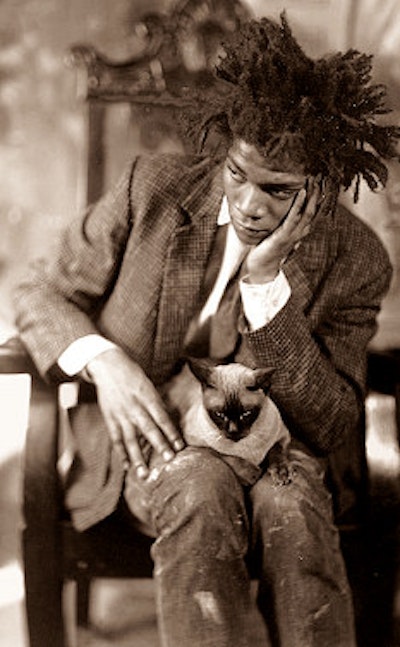
Jean - Michel Basquiat
Jean-Michel Basquiat (New York, 1960 - 1988), nasceva il 22 di dicembre di sessant’anni fa, tra le vie allora degradate di Brooklyn. Basquiat fu simbolo di quella beat generation che rivoluzionò le vie dell’arte contemporanea. Noto e celebrato per i suoi graffiti metropolitani, è, con Keith Haring di cui fu strettissimo amico, al vertice di coloro che ebbero il merito di muovere la street art dai sobborghi di periferia alle esposizioni nei musei di tutto il mondo come arte vitale e riconosciuta senza mai rinnegare le proprie origini.
Il mito che accompagna la sua carriera luminosa e velocissima, conclusasi per una morte prematura data da instabilità ed eccessi a soli 28 anni tra le trafficatissime strade di New York, resta iconica per un’intera generazione, quella della pop art, che nell’ultima parte dello scorso secolo ha fatto la storia dell’arte contemporanea e di una cultura vitale e sincera, ma allo stesso tempo raffinata, di cui oggi siamo i diretti discendenti.
Figlio di padre haitiano e madre americana di origini portoricane. Origine, questa, che segna il suo ruolo di artista e portavoce della cultura afroamericana. Già dai 4 anni si interessa al disegno e al fumetto ed è trascinato dalla madre tra le varie mostre che abitano New York, in quegli anni capitale della nascente arte contemporanea. Figlio geniale e irrequieto, all’età di 11 anni parla già anche in francese e spagnolo ma è troppo indisciplinato, tanto da essere spedito in rieducazione a Manhattan alla City-as-a-School, istituto sperimentale per ragazzi dotati ma restii all’istruzione tradizionale. È lì che conoscerà Al Diaz, con il quale comincia a girovagare di notte per la città svuotando le sue bombolette qua e là, talvolta sotto l’effetto di LSD. La prima esperienza artistica, secondo le parole di Jean-Michel, nacque proprio così: «Una notte stavamo fumando erba ed io dissi qualcosa sul fatto che fosse sempre la stessa merda, The Same Old Shit. SAMO, giusto? Immaginatevi: vendere pacchi di SAMO! È così che iniziò, come uno scherzo tra amici, e poi crebbe.» E crebbe a tal punto che i SAMO vengono notati dal settimanale d’arte Village Voice nel 1978, nonostante il litigio tra i due e la fuga da casa che spinse Basquiat a vivere a lungo come vagabondo tra Brooklyn e l’East Village a Manhattan.
Era ormai arrivato il tempo per il definitivo riconoscimento. Basquiat tentò più volte di avvicinare a New York il re della pop art, Andy Warhol, finché l’approccio gli riuscì e i due tesserono un legame che portò in primo luogo alla promozione dell’arte di Jean-Michel nei musei di tutto il mondo e poi a un’influenza reciproca che i due artisti raffigureranno come un incontro di boxe ancora oggi iconico – Basquiat paragonava il mondo dell’arte a un ring, seguendo lo sport di cui era appassionatissimo.
L’improvvisa scomparsa del maestro-rivale, dovuto alle conseguenze di un intervento alla cistifellea, rigettò Jean-Michel tra i demoni di una vita precoce e giovanissima condizionata dalla strada e dalla sfortuna – letteralmente, gli era stata asportata la milza dopo essere stato investito da un’automobile durante uno dei suoi vagabondaggi notturni nel 1968. Nonostante l’amicizia con i più influenti artisti degli anni ’80 come il collega Keith Haring e una relazione con l’allora sconosciuta cantante Madonna, l’artista cadde in una pesante dipendenza dall’eroina che lo condusse alla morte nel 1988, lasciando ai posteri il rimpianto di una vita esauritasi troppo in fretta.
English
Jean-Michel Basquiat, (born December 22, 1960, Brooklyn, New York, U.S.—died August 12, 1988, New York City), American painter known for his raw gestural style of painting with graffiti-like images and scrawled text.
Basquiat was raised in a middle-class home in Brooklyn. His mother was an American of Puerto Rican descent. She encouraged Basquiat’s interest in art, taking him to New York City’s great art museums. His parents eventually separated, and he and his sisters lived with their father in Puerto Rico from 1974 to 1976. His mother was diagnosed as mentally ill and eventually was institutionalized. Troubled by his early childhood, Basquiat dropped out of high school and left home at age 17. He lived on the streets, with friends, or in abandoned buildings and began a graffiti campaign with graffiti artists Al Diaz and Shannon Dawson. They created the persona SAMO© (said to represent “same old shit”) and painted anonymous messages—“(SAMO©) A PIN DROPS LIKE A PUNGENT ODOR…” and “SAMO©…JUST IN CASE…”—on walls around SoHo and the East Village and on the D train of the New York City subway system. In the late 1970s that work—together with the work of other graffitists—began to receive notice in the art world, and so did Basquiat. He emerged in the aboveground New York art scene at age 20, about the time that a resurgence of Expressionist painting was at its height, and participated in his first formal public exhibition in “The Times Square Show” (1980). From there his career skyrocketed, and, until his death in 1988, he was a celebrity, represented by major blue-chip galleries in New York and Germany.
Lacking any formal training, Basquiat created highly expressionistic work that mixed graffiti and signs with the gestural and intuitive approach of Abstract Expressionist painting. Although much of his work addressed his personal angst in highly stylized self-portraits, he also alluded to African American historical figures, including jazz musicians, sports personalities, and writers. He appropriated and freely mixed motifs from African, Caribbean, Aztec, and Hispanic cultures and mixed “high art” references with images from popular culture, especially cartoons.
In 1981 Basquiat was the subject of an article by art critic René Ricard in Artforum magazine. The young artist was befriended by the Pop artist Andy Warhol in 1983, and the two began to collaborate occasionally. In 1985 Basquiat appeared on the cover of the weekly New York Times Magazine as a representative of the contemporary art-marketing trend. Three years later, at age 27, he was found dead in his loft from an overdose of heroin.
